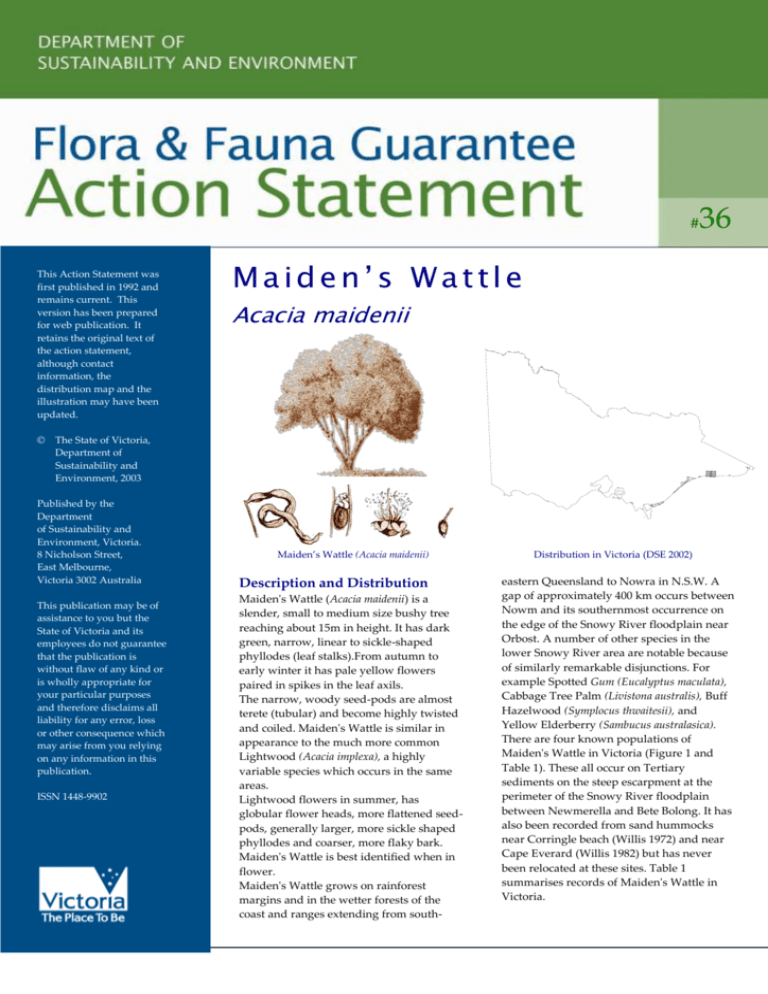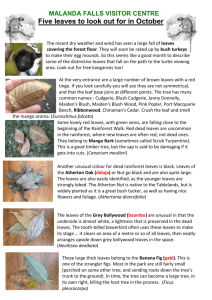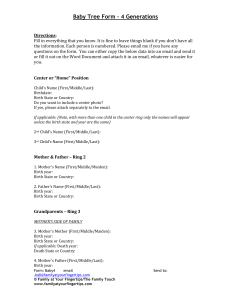Conservation Status Current Status Gullan et al. (1990) Endangered
advertisement

# This Action Statement was first published in 1992 and remains current. This version has been prepared for web publication. It retains the original text of the action statement, although contact information, the distribution map and the illustration may have been updated. Maiden’s Wattle 36 5 Acacia maidenii © The State of Victoria, Department of Sustainability and Environment, 2003 Published by the Department of Sustainability and Environment, Victoria. 8 Nicholson Street, East Melbourne, Victoria 3002 Australia This publication may be of assistance to you but the State of Victoria and its employees do not guarantee that the publication is without flaw of any kind or is wholly appropriate for your particular purposes and therefore disclaims all liability for any error, loss or other consequence which may arise from you relying on any information in this publication. ISSN 1448-9902 Maiden’s Wattle (Acacia maidenii) Description and Distribution Maiden's Wattle (Acacia maidenii) is a slender, small to medium size bushy tree reaching about 15m in height. It has dark green, narrow, linear to sickle-shaped phyllodes (leaf stalks).From autumn to early winter it has pale yellow flowers paired in spikes in the leaf axils. The narrow, woody seed-pods are almost terete (tubular) and become highly twisted and coiled. Maiden's Wattle is similar in appearance to the much more common Lightwood (Acacia implexa), a highly variable species which occurs in the same areas. Lightwood flowers in summer, has globular flower heads, more flattened seedpods, generally larger, more sickle shaped phyllodes and coarser, more flaky bark. Maiden's Wattle is best identified when in flower. Maiden's Wattle grows on rainforest margins and in the wetter forests of the coast and ranges extending from south- Distribution in Victoria (DSE 2002) eastern Queensland to Nowra in N.S.W. A gap of approximately 400 km occurs between Nowm and its southernmost occurrence on the edge of the Snowy River floodplain near Orbost. A number of other species in the lower Snowy River area are notable because of similarly remarkable disjunctions. For example Spotted Gum (Eucalyptus maculata), Cabbage Tree Palm (Livistona australis), Buff Hazelwood (Symplocus thwaitesii), and Yellow Elderberry (Sambucus australasica). There are four known populations of Maiden's Wattle in Victoria (Figure 1 and Table 1). These all occur on Tertiary sediments on the steep escarpment at the perimeter of the Snowy River floodplain between Newmerella and Bete Bolong. It has also been recorded from sand hummocks near Corringle beach (Willis 1972) and near Cape Everard (Willis 1982) but has never been relocated at these sites. Table 1 summarises records of Maiden's Wattle in Victoria. Table 1: Victorian records of Maiden's Wattle Population Location Description 1 Burn Rd, Newmeralla Approx. 200 individuals on less than 1 Road Reserve ha. Ages range from 1 to,approx. 30 years Land Status 2 Gully above OrbostBuchan Rd Small stand adjacent to rainforest gully. Many seedlings following a fuel reduction burn 1-2 years ago. Private property 3 Below Deasey Rd, Bete Bolong Small stand (0.6 ha) Private property and unused road reserve 4 Bete Bolong Rd Several hundred trees in numerous stands scattered over 20 ha. Wide variety Private property and roadside of ages. 5 On sand hummocks Historical record (Willis 1972). 6 Cape Everard Historical record (Willis 1972). ? National Park All populations were last recorded in 1992 except population 5 and 6, last recorded in 1970s(?). Conservation Status Current Status Gullan et al. (1990) Endangered Maiden's Wattle has been listed as a threatened taxon on Schedule2 of the Flora and Fauna Guarantee Act 1988. Reasons for Conservation Status Prior to clearing of the Snowy River flats and adjacent slopes, Maiden's Wattle would have been more cornmon. It is now confined to small stands that are at considerable risk from burning, grazing, roadworks, and weed invasion. In its final recommendations, the Scientific Advisory Committee (1992) has determined that Maiden's Wattle is: significantly prone to future threats which are likely to result in extinction; and very rare in terms of abundance and distribution. Major Conservation Objectives Increase the size of existing populations to at least 500 plants per site. Establish major new populations (greater than 500 plants) on the escarpment above Lochend and Lake Wat Wat. Bring Maiden's Wattle into cultivation in local gardens and amenity plantings at Newmerella, Orbost and the Royal Botanic Gardens. Management Issues Roadside Works The Burns Rd. and Bete Bolong roadside populations could be unintentionally damaged or eliminated by works associated with road improvement or power and telephone supply.f its life history (Beardsell, Carr, Eichler, pers. comm.) Grazing Domestic and introduced herbivores may prevent recruitmentof Maiden's Wattle by eating young seedlings or suckers. Fire Management The escarpment where Maiden's Wattle occurs is steep and carries inflammable native and weedy vegetation. Protection of farm buildings, houses and public utilities above the escarpment may necessitate fuel reduction burns from time to time. Anecdotal evidence suggests that Maiden's Wattle regenerates from soil-stored seed following fire (P. Fagg, pers. comm.) and that it can produce suckers (Author's observations). However, if frequent burning could kill seedlings before they reach reproductive maturity, deplete soilstored seed and lead to population decline. Weed Invasion The escarpment is also heavily weed infested due to the proximity of farmland and domestic gardens, and a history of disturbance. Spanish Heath (Erica lusitanica) is becoming established on roadsides in Newmerella and may take over Maiden's Wattle habitat if not controlled. Blackberries (Rubus fruticosus sp. agg.), which are abundant amongst the Bete Bolong population, may be preventing establishment of Maiden's Wattle seedlings. Ecological Issues Specific to the Taxon Maiden's Wattle is a long-lived rainforest edge species. In its natural setting it was probably favoured by infrequent fires that petered out as they backed downslope toward rainforest or moist gully vegetation. Frequent fire may favour more opportunistic species such as Lightwood. Rainforest restoration and revegetation is a high priority in the lower Snowy River area. Remnant Maiden's Wattle stands provide useful clues about former rainforest distribution. Planting of Maiden's Wattle along selected rainforest margins will help restore the rainforest ecotone structure to the original condition. 2 Wider Conservation Issues Conservation and re-establishment of Maiden's Wattle will be an integral part of the gradual restoration of remnant vegetation on the lower Snowy River. As Maiden's Wattle is a secondary rainforest species, establishment of populations at Lochend and Lake Wat Wat is an important part of rainforest rehabilitation at those sites. Other relevant work under way at these sites includes environmental weed control, revegetation, fencing, and planting of other significant plant species such as White Supplejack (Ripogonum album) and Yellow Elderberry (Sambucus australasicus). Social and Economic Issues The social and economic issues associated with the conservation of Maiden's Wattle are minor. Future roadworks, including widening, and service provision could be restricted at the public land sites. Authorities responsible for works on or near these sites must also take care to ensure that they do not inadvertently damage any plants. Maiden's Wattle sites on private land provide good opportunities for land holder extension. Protection of Maiden's Wattle could have minor impacts on grazmg and fire prevention activities. Management Action Previous Management Action Consultation with landowners regarding protection of the Deasey Rd. and Bete Bolong populations on private land has been ongoing since 1991. Seed was collected from the Burns Rd. population and lodged with the Royal Botanic Gardens for propagation in 1991. The Newmerella Rural Fire Brigade was consulted regarding burning adjacent to the Burns Rd, and cooperative efforts to protect these populations will proceed. Orbost Primary School students and representatives from Orbost and District Environment Group were shown the Burns Rd. population in Autumn 1992. An article in the Snowy River Mail followed these inspections. A radio interview on Maiden's Wattle was broadcast on the ABC Gippsland Morning program during Winter 1992. Arrangements are under way for construction of a greenhouse and propagation facility at the Orbost Rainforest Centre. This will be used for propagation of Maiden's Wattle and other threatened species in the Orbost Region. Intended Management Action Protection of Deasey Rd. Population This population is partly on private land and partly on an unused road reserve. Fencing to prevent cattle grazing is desirable for long-term protection of this site. The possibility of a mutually beneficial land exchange is currently being investigated. Protection of Bete Bolong Population This population is nearly entirely on private land and is by far the best remaining population in Victoria. Ongoing liaison with the landowner will ensure that the population remains viable. Assistance will be provided for Blackberry control and for protection of Maiden's Wattle when appropriate. Establishment of New Populations New'populations will be established on public land at Lochend and Lake Wat Wat. Enrichment Planting Existing populations at Burns Road and on Bete Bolong Road will be expanded by planting and, if possible, by direct seeding. Cultivation Maiden's Wattle will be cultivated at the Royal Botanic Gardens and the Orbost Rainforest Centre. Arrangements for commercial pmpgation and sale through local nurseries will be investigated Distribution of Plants Seedlings of Maiden's Wattle will be given to interested local residents and agencies to plant in gardens or for public amenity in the area. Signposting Signs will be installed at the vulnerable roadside populations on Burns Road and on Bete Bolong Road to raise public awareness and prevent inadvertant darnage. Information Sheet An illustrated information sheet on Maiden's Wattle will be prepared to aid identification. Tbis will be distributed to the local community. Fire Management Liaise with the Newmerella Rural Fire Brigade and private landholders to ensure appropriate fire management of Maiden's Wattle sites. Suitable fire frequency will vary according to the age structure of the Maiden's Wattle stand, the type of understorey, and the quantity and type of fuel present. As a general guide a burning cycle of 15 years should ensure adequate recruitment and allow seedlings to reach reproductive maturity. Environmental Weed Control Control Spanish Heath on Newmerella cutting and on roadsides in the Newmerella area where competition with Maiden's Wattle is likely. Legislative Powers Operating Legislation The Flora and Fauna Guarantee Act 1988 provides for listing of Maiden's Wattle, determination of its critical habitat, permits for collection of the species, and requires production of this action statement. 3 Planning and Environment Act 1987 provides controls over the clearing of native vegetation on public and private land. Country Fire Authority Act 1958 provides for fire protection in rural areas. Crown Land (Reserves) Act 1978 provides for the creation and management of reserves. Licence/Permit Conditions Permits for collection of seed or other parts of Maiden's Wattle will only be given in accordance with the objectives of this action statement. Permits for clearing Maidens's Wattle will generally not be granted. Consultation and Community Participation Schools and community groups will be invited to be involved in propagating and planting Maiden's Wattle. Private landholders with Maiden's Wattle on their land will play an important role in its conservation in Victoria. Close liaison and co-operation with the following bodies will help the successful implementation of this action statement: Shire of Orbost Newmerella Rural Fire Brigade Newmerella Primary School Orbost District Environment Group.. Implementation, Evaluation and Review The Regional Manager, Orbost, will be responsible for implementation of this action statement. Progress towards achieving the major conservation objectives of this action statement will be evaluated annually. Contacts Management District Manager, Orbost Flora and Fauna Guarantee Officer, Orbost Biology David Cameron, Botanist DCE Flora and Fauna Guarantee Officer, Orbost 4 References Compiler Mansergh, I.M. (1984) B. Thompson Further information Further information can be obtained from Department of Sustainability and Environment Customer Service Centre on 136 186. Flora and Fauna Guarantee Action Statements are available from the Department of Sustainability and Environment website: http://www.dse.vic.gov.au References Cameron, D.G.(nd) Acacia maidenii. Unpublished notes. DSE (2002) Flora Information System (Electronic Flora Database). Parks, Flora & Fauna, Department of Sustainability & Environment, East Melbourne. Gullan, P.K., Cheal, D.C., andWalsh N.G.(1990) Rare or Threatened Plants in Victoria. Department of Conservation and Environment, Victoria. Morrison, D.A. and Davies, S.J. (1991) Acacia, in Harden, G.J.(ed) Flora of New South Wales 2:352. Royal Botanic Gardens, Sydney. Scientific Advisory Committee, Flora and Fauna Guarantee, Victoria (1992). Final Recommendation on a nomination for listing: Acacia maidenii (Nomination 212). Department of Conservation and Environment, Victoria. Wiflis, J.H.(1972) A Handbook to Plants in Victoria. Volume 2. MUP. Willis, J.H.(1982) 507 Species of indigenous Victorian plants which are variously rare, very localized and/or endangered, with localities as far as known (unpublished). . Personal Communications Peter Fagg, Native Forest Management Branch, CNR. 5







